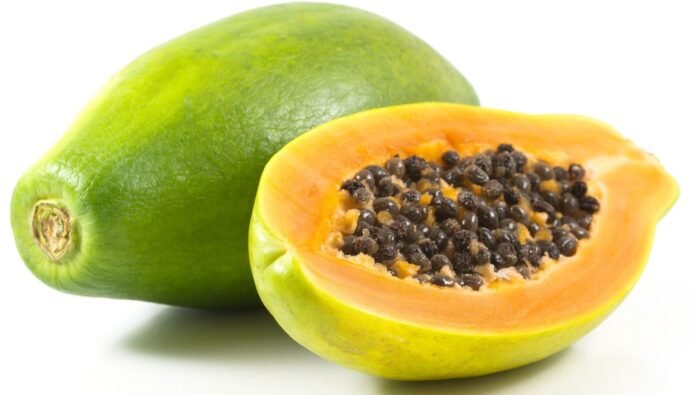Introduction
The papaya plant, with its palmlike trunk that can reach up to 8 meters (26 feet) in height, is considered a tree despite not having a very woody trunk. It has deeply lobed leaves that can be up to 60 cm (2 feet) in size, with hollow leaf stalks up to 60 cm long. The species is typically dioecious, with male and female flowers produced on separate plants, although hermaphroditic forms exist and irregularities in sex distribution are common. The male flowers are funnel-shaped, whitish, and have ten stamens in the throat. In contrast, the female flowers are more significant, have five united fleshy petals, and have a cylindrical or globose ovary with five sessile stigmas.
What is Papaya’s Botanical name?
Papaya, scientifically known as Carica papaya, belongs to the genus Carica comprising 22 species. This tropical and subtropical fruit tree is sparsely branched, and its origin can be traced back to different regions across the globe.
The primary objective of cultivating papaya is for its fruit, which possesses a natural sweetness when ripe. The fruit also contains various nutrients, including high levels of vitamin C and antioxidants such as lycopene.
Different between both Carica papaya and Papaya Plant
Differences Between Carica papaya and Papaya Plant
Carica papaya:
- Botanical name: Carica papaya
- Family: Caricaceae
- Common name: Pawpaw
- Habitat: Native to Mexico and northern regions of South America
- Description: Herbaceous plant that bears fruit
Papaya Plant:
- Description: Tropical tree that bears orangish-yellow fruit
- Cultivation: Widely cultivated for its use in medicine and pharmacology
- Consumption: Popularly eaten as a breakfast fruit and in juices in various countries
Papaya Cultivation, Disease Challenges, and Genetically Modified Varieties
Papayas are a popular fruit commonly grown from seeds due to their ease of propagation. Papaya plants proliferate and typically produce fruit within the first year of growth. In optimal conditions, papaya plants can live for five years or more, making them a long-lasting addition to gardens and orchards.
However, papaya crops worldwide faced a significant challenge from the papaya ringspot virus, which first emerged in Hawaiian plantations during the 1940s. This disease rapidly spread to other regions, nearly wiping out papaya crops globally.
To combat this disease, researchers developed a genetically modified variety known as the Rainbow papaya in the early 2000s. This variety was created with resistance to the papaya ringspot virus and was one of the first GMO fruits to enter commercial production. Nowadays, the majority of exported papayas are genetically modified to resist diseases.
Benefits of Papaya Leaves
Papaya leaves, scientifically known as Carica papaya, offer a variety of health benefits. Here are some of the ways papaya leaves can be beneficial:
- Dengue fever treatment: Papaya leaf extract can help alleviate the symptoms of dengue fever, a viral infection transmitted by mosquitoes.
- Blood sugar regulation: Papaya leaves may help regulate blood sugar levels, making them a potential aid for those with diabetes or at risk of developing the condition.
- Digestive support: The enzymes in papaya leaves can aid in the digestion of proteins and improve gut health.
- Anti-inflammatory properties: Papaya leaves contain compounds with anti-inflammatory properties, which may help alleviate inflammation in the body.
- Hair growth: Papaya leaves have been shown to support hair growth in some cases, possibly due to their high content of vitamins and antioxidants.
Types of Papaya Leaves
Some closely related species of citrus trees, often known as limes, are utilized in ways similar to Persian and Key limes.
The fruit and leaves of the Thai lime, also known as makrut lime (C. hystrix), provide Southeast Asian dishes with a distinctive taste. They are also sometimes used in fragrances.
The Mediterranean area extensively cultivates sweet lime (C. limetta), which is less acidic than Persian lime.
The Rangpur lime (C. limonia), sometimes known as the mandarin lime and often used to produce marmalade, is a cross between the lemon and the mandarin orange.
Young finger limes (C. Australasia), endemic to Australia, are prized for their characteristic juice vesicles, often called “lime caviar.”
Uses of Carica Papaya
It’s a tropical fruit-bearing plant in the Caricaceae family and is commonly consumed raw in several countries, including Vietnam and Thailand. In certain regions, the unripe green fruit is cooked and served as a dish. Additionally, the seeds of the papaya fruit, when black, are consumed and provide an intense and zesty flavor. Understanding the botanical properties and culinary applications of Carica papaya can provide valuable insight into its multifaceted uses.
Papaya Tree Lifespan
The lifespan of a papaya tree is generally limited to 3-4 years, despite being a fruit-bearing plant. The quantity of fruit produced during this duration varies depending on the prevailing climate and soil conditions.
Papaya Botanical Name FAQs
Q1. What is the botanical name of papaya?
Ans. Carica papaya
Q2. What family does papaya belong to?
Ans. Papaya belongs to the Caricaceae family, and its botanical name is Carica papaya. Originally from America, papaya can now be grown in many regions worldwide.
Q3. What is the common name of Carica papaya?
Ans. Carica papaya is commonly known as pawpaw. It is a tropical fruit tree native to Mexico and northern South America. Papaya is now widely cultivated for its medicinal properties and is enjoyed by many countries as a breakfast food or in juices.
Q4. What type of fruit is papaya?
Ans. Papaya is classified as a berry fruit, which is fleshy and contains numerous seeds. Berry fruits typically develop from a single ovary of a flower.
Q5. Where is papaya cultivated?
Ans. Papaya is native to the tropics of the Americas. It is cultivated in most countries with a tropical or warm semi-tropical climate, like Brazil, India, South Africa, Sri Lanka, and the Philippines.
